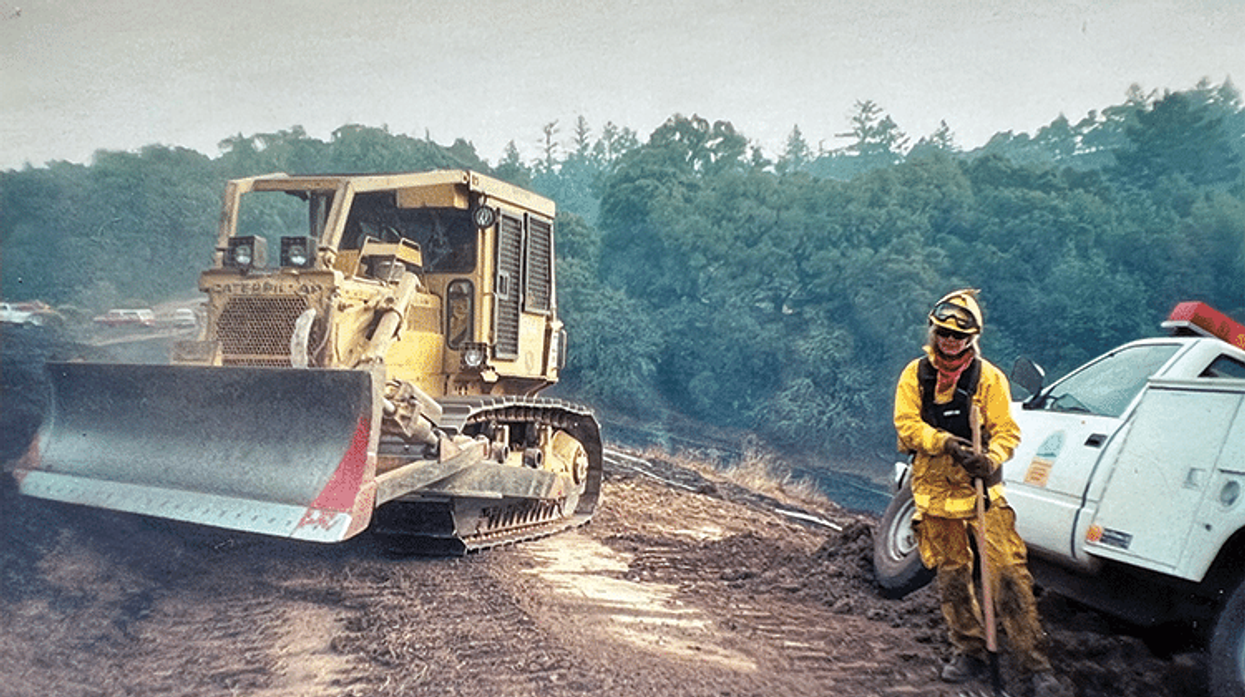Print Issue
Even Disaster Won't Stop LGBTQ+ Travelers

Climate change has travelers worried about destinations disappearing, but this former fire fighter knows there's still reason to hope.
March 29 2022 10:59 PM EST
By continuing to use our site, you agree to our Privacy Policy and Terms of Use.

Climate change has travelers worried about destinations disappearing, but this former fire fighter knows there's still reason to hope.
The world is on fire. At least that’s how it can feel, as the pandemic and climate crisis continue to thwart our lives. I know a bit about fire (that’s me in the picture above fighting wildfires in the Santa Cruz Mountains as an open space ranger in 2003). What I know actually gives me hope.
Fire swept across Yellowstone National Park in the summer of 1988. A little over two hours from my childhood home 50 separate fires would grow to become the park’s largest wildfire in recorded history; the inferno eventually burned 793,880 acres, an area larger than the state of Rhode Island.
As the fires raged and areas around Yellowstone were evacuated, my dad, G. Wayne Minshall — an Idaho State University stream ecologist — gathered up his graduate students and drove into the burn area to take benthic samples. The fires gave them an unprecedented opportunity to collect samples directly before and after fires burned an area. While some tourists stayed away far too long, still mourning the park’s destruction, others soon flocked to see the devastation — and were stunned that so much remained unchanged. It’s hard to burn hot springs and geysers, but amid the blackened trees was also a blanket of the most gorgeous wildflowers seen in Yellowstone in decades.
My dad’s groundbreaking research demonstrated how rivers recover from fire over time. What the Yellowstone fires taught me was that nature was far more resilient than we often imagine. That gives me hope, even as the climate crisis threatens some of our favorite places. Of course, the impact of climate disasters is growing (in 2020, California’s “August Complex” fire burned 1,032,648 acres) and already stressed ecosystems have a harder time recovering. So, like you, we still worry.
Fears about the potential devastation of the planet have sparked a growing trend: last chance tourism or what some call doomsday travel. Last chance travel is the desire to see or experience threatened species, cultures, ecosystems, or cities before they are gone. In our Spring edition of Out Traveler we consider the impact of last chance travel, sharing some of the places we’re most driven to visit, stories of once-in-a-lifetime experiences, how to travel without endangering the people and animals who live there, alternatives to threatened locales, and yes, even the role travel plays in further threatening the places many of us long to visit.
At Out Traveler, we’re convinced that travel has the potential to do more good than harm especially when we learn to do good as we go (for example, in this issue we showed how tourists can help restore Mexico City’s precolonial canals or help save the Great Barrier Reef by only using authorized guides).
We cover Mexico in depth this issue as our writers fanned out across the nation to explore different regions and a burgeoning foodie scene.
Our cover queen Trixie Mattel tells us about bringing her retro-kitch, Barbie doll aesthetic to Palm Springs, renovating a California motel on the new Discovery+ show Trixie Motel.
When you venture out again, we’ve got lots of inspiration, tips, and #IRL experiences of LGBTQ+ people, including yoga juggernaut Jessamyn Stanley and Grown-ish star Warren Egypt Franklin.
Where ever you go, always look for the flowers after the fire.
Jacob Anderson-Minshall
Editor in Chief